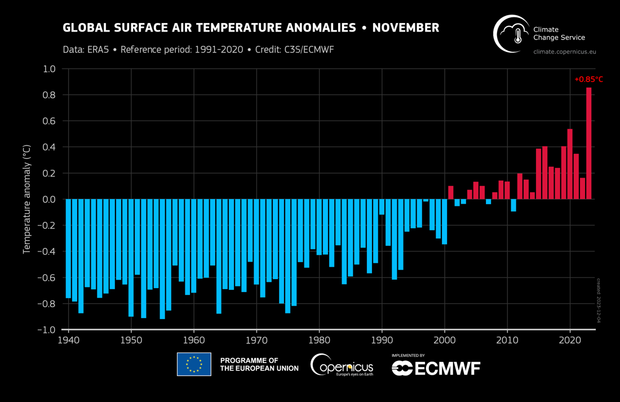
2023 is officially the hottest year ever recorded, and scientists say “the temperature will keep rising”
After months of expectation, it’s official — 2023 will be the hottest year ever recorded. The European Union’s Copernicus Climate Change Service announced the milestone after analyzing data that showed the world saw its warmest-ever November.
Last month was roughly 1.75 degrees Celsius warmer than the pre-industrial average, Copernicus said, with an average surface air temperature of 14.22 degrees Celsius, or about 57.6 degrees Fahrenheit. And now, Copernicus says that for January to November 2023, global average temperatures were the highest on record — 1.46 degrees Celsius above the pre-industrial average.
Data source: ERA5 / Credit: C3S/ECMWF
The boreal autumn, from September through November, was also the warmest as a whole “by a large margin,” Copernicus said, with temperatures 0.88 degrees Celsius above average. In September, it reported that the summer of 2023 was the hottest on record.
already worsened — will become even more frequent and intense, exacerbating the damage and loss of life from droughts, flooding, hurricanes and wildfires.
Data source: ERA5 / Credit: C3S/ECMWF
And it wasn’t just the air that was warmer last month, but the water too.
Copernicus said that the average sea surface temperature for ocean waters between 60ºN and 60ºS — roughly between the southern tip of Greenland to just below South America — was the highest on record, about 0.25 degrees Celsius warmer than the last record-breaking November, in 2015.
Copernicus warned of this outcome last month, saying the warmest-year title was “virtually certain.”
The World Meteorological Organization, an agency of the United Nations, reiterated the warning at the U.N.’s COP28 climate summit just days ago, saying that the extreme conditions experienced this year have “left a trail of devastation and despair.”
The WMO also put out a report Tuesday saying that the rate of climate change has “surged alarmingly,” with 2011 to 2020 being the warmest decade on record.
At COP28, efforts to cut emissions — but how soon?
Global temperatures are a major point of discussion at the COP28 summit in Dubai, which runs through Dec. 12. Greenhouse gases, which include carbon dioxide and methane among others, are gases that trap heat within Earth’s atmosphere, warming air temperatures and melting sea ice, which then warms ocean temperatures and causes sea levels to rise. Most of the emissions of those gases come from the burning of fossil fuels, which include coal, natural gas and oil.
Carlo Buontempo, director of the Copernicus Climate Change Service, said the extreme temperatures seen this year will only continue if drastic changes aren’t made quickly.
“As long as greenhouse gas concentrations keep rising we can’t expect different outcomes from those seen this year,” Buontempo said. “The temperature will keep rising and so will the impacts of heatwaves and droughts. Reaching net zero as soon as possible is an effective way to manage our climate risks.”
Moving from the burning of oil and coal to sources like wind and solar energy is an essential step to cutting emissions, scientists say. One study published in 2022 found that for every 1 percentage point increase in renewable energy consumption, CO2 emissions per capita would be reduced by 1.25%. The National Renewable Energy Laboratory, which is a part of the U.S. Department of Energy, has also found that adding 35% more wind and solar energy would reduce carbon emissions by 25% to 45%.
There have been strides in ramping up renewable energy worldwide. Just this year, the U.S. generated more electricity from solar and wind than from coal for a record 5 months, and the U.K. generated more power with wind than with gas for the first time ever. But many countries, including the U.S., are still far behind on their commitments for making substantial changes.
At COP28, representatives from nearly 200 countries are hashing out plans to move from fossil fuels to renewable energy. The big debate is whether they will agree to “phase out” or “phase down” fossil fuels — the latter of which would be a slower, weaker global stance on the transition.
“If you’re digging a hole and you get too deep and you’re not going where you want to go, first thing you do is stop digging,” U.S. climate envoy John Kerry said at COP28. “And the equivalency of stopping digging on this subject of climate is to stop emitting these poisonous gases athat are destroying the planet and the lives of future generations and our own ability to live. … We’re asking you to actually embrace a better quality of life.”
More
More
Source: cbsnews.com

